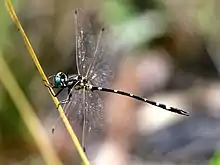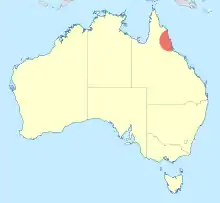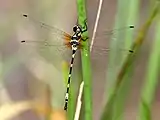Tonyosynthemis claviculata
Tonyosynthemis claviculata, commonly known as the clavicle tigertail, is a species of dragonfly.[4] They are found in Queensland, Australia, along streams and rivers, or near the eastern Australian coast and drainage basins.[4]
| Tonyosynthemis claviculata | |
|---|---|
 | |
| Male, Queensland, Australia | |
| Scientific classification | |
| Kingdom: | Animalia |
| Phylum: | Arthropoda |
| Class: | Insecta |
| Order: | Odonata |
| Infraorder: | Anisoptera |
| Family: | Synthemistidae |
| Genus: | Tonyosynthemis |
| Species: | T. claviculata |
| Binomial name | |
| Tonyosynthemis claviculata | |
 | |
| Synonyms[3] | |
|
Synthemis claviculata Tillyard, 1909 | |
Body
The hindwing of an average adult is generally 30 mm or larger.
Male
One of the specimens that scientist Günther Theischinger collected and studied was male of medium length. The majority of its body was colored black, with some yellow patterns. Unlike the rest of its body, the bases of its wings (also known as subcostal space) were not black in color. The abdomen and tergum of the specimen was without a distal hair-brush, but had small, short hairs. The upper majority of the male's anal appendages were club-shaped and curved.[5]
Female
Another of the specimens that Theischinger collected was female and of medium length. The majority of its body was colored black, with some yellow patterns. Unlike the rest of its body, the bases of its wings were not black in color. The abdomen and tergum of the specimen was without distal hair-brush, but had small, short hairs. The female's genital valves were narrow in measure, with a developed styli and a laterodistal point.[5]
Larvae
One of the smaller specimens that Theischinger collected was a larva of average length. The body measured about 19 mm, its prementum was of a fair width and its ligula and median lobe still were in the process of development. The specimen's labial palps were still relatively small, but also had six large palpal setae, and its postocular lobe was rather bilobed. The larvae's pronotal lobe was well developed and included short setae, while its abdomen had obtuse laterodorsal on five segments.[5]
Gallery
 young female, north Queensland
young female, north Queensland.jpg.webp) Female wings
Female wings.jpg.webp) Male wings
Male wings
References
| Wikimedia Commons has media related to Tonyosynthemis claviculata. |
- Dow, R.A. (2017). "Tonyosynthemis claviculata". IUCN Red List of Threatened Species. 2017: e.T87539873A87540224. doi:10.2305/IUCN.UK.2017-1.RLTS.T87539873A87540224.en.
- Tillyard, R.J. (1909). "On some remarkable Australian Corduliinae, with descriptions of new species". Proceedings of the Linnean Society of New South Wales. 33 (1908): 737–751 [749] – via Biodiversity Heritage Library.
- Martin Schorr; Martin Lindeboom; Dennis Paulson. "World Odonata List". University of Puget Sound. Archived from the original on 28 August 2010. Retrieved 11 August 2010.
- Theischinger, Günther; Hawking, John (2006). The Complete Field Guide to Dragonflies of Australia. Collingwood, Victoria, Australia: CSIRO Publishing. p. 204. ISBN 978 0 64309 073 6.
- Theischinger, Günther. "Tonyosynthemis, a new dragonfly genus from Australia (Insecta: Odonata: Synthemistidae)" (PDF). Austria: Biologiezentrum Linz/Austria. Retrieved 1 January 2010.
